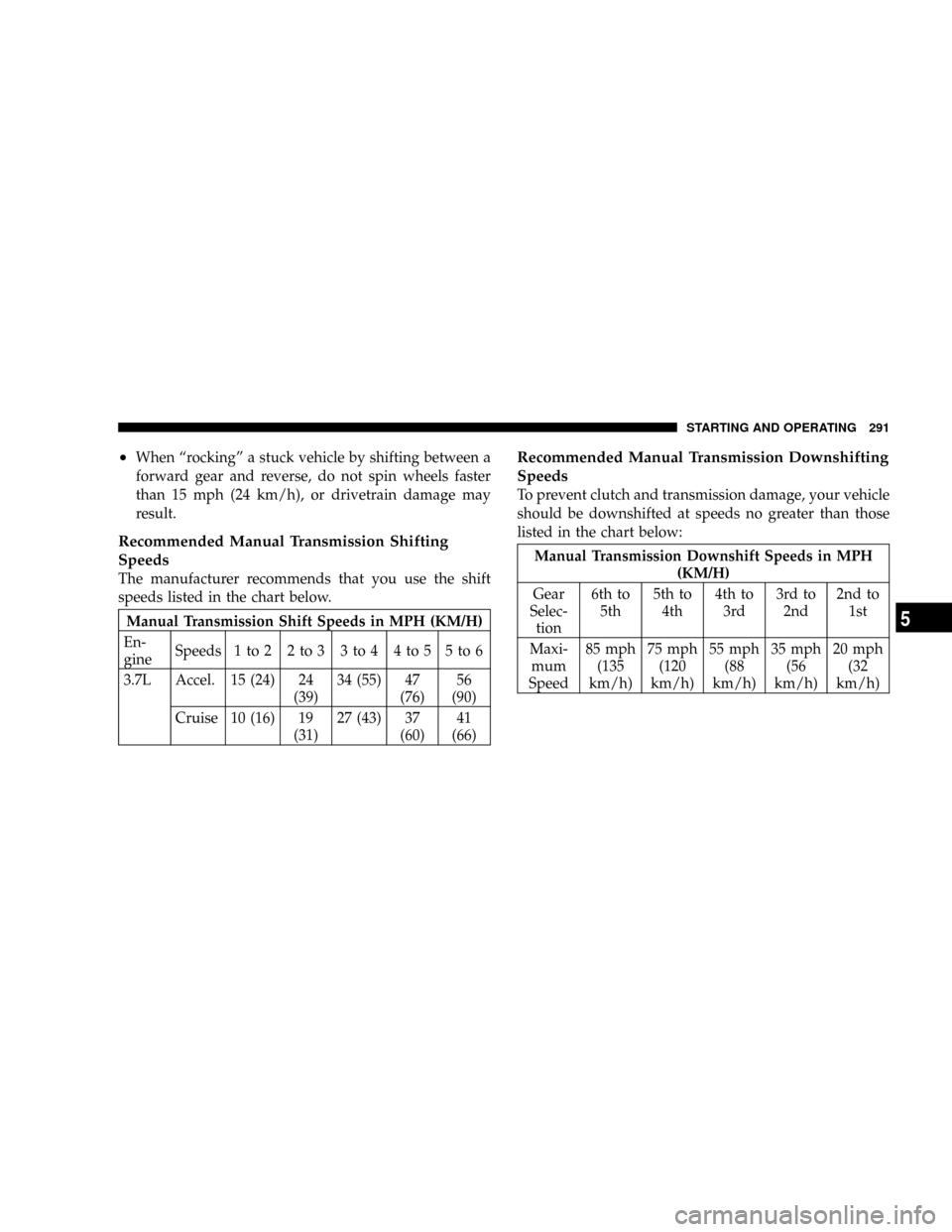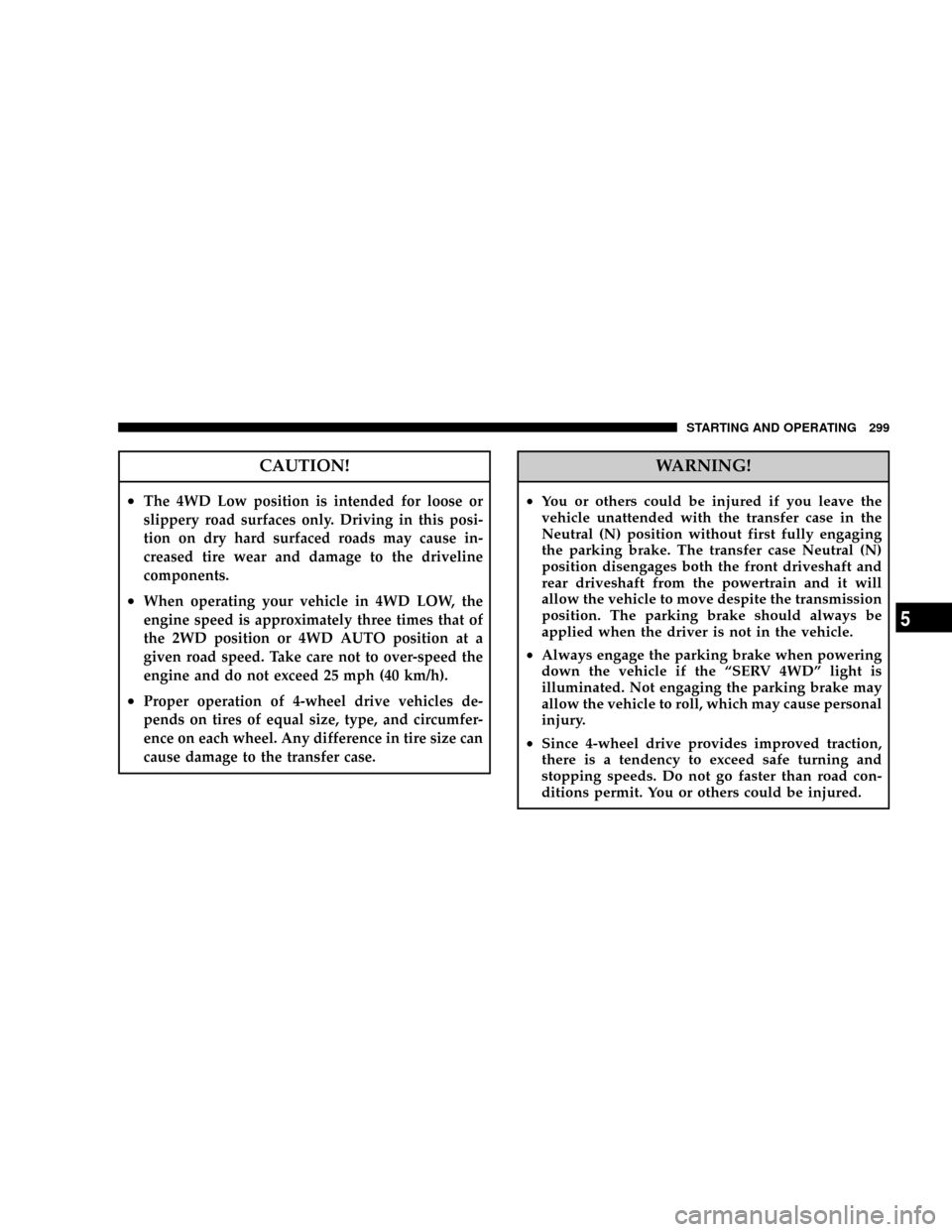JEEP LIBERTY 2008 KK / 2.G Owners Manual
Manufacturer: JEEP, Model Year: 2008, Model line: LIBERTY, Model: JEEP LIBERTY 2008 KK / 2.GPages: 493
Page 291 of 493

²When ªrockingº a stuck vehicle by shifting between a
forward gear and reverse, do not spin wheels faster
than 15 mph (24 km/h), or drivetrain damage may
result.
Recommended Manual Transmission Shifting
Speeds
The manufacturer recommends that you use the shift
speeds listed in the chart below.
Manual Transmission Shift Speeds in MPH (KM/H)
En-
gineSpeeds 1 to 2 2 to 3 3 to 4 4 to 5 5 to 6
3.7L Accel. 15 (24) 24
(39)34 (55) 47
(76)56
(90)
Cruise 10 (16) 19
(31)27 (43) 37
(60)41
(66)
Recommended Manual Transmission Downshifting
Speeds
To prevent clutch and transmission damage, your vehicle
should be downshifted at speeds no greater than those
listed in the chart below:
Manual Transmission Downshift Speeds in MPH
(KM/H)
Gear
Selec-
tion6th to
5th5th to
4th4th to
3rd3rd to
2nd2nd to
1st
Maxi-
mum
Speed85 mph
(135
km/h)75 mph
(120
km/h)55 mph
(88
km/h)35 mph
(56
km/h)20 mph
(32
km/h)
STARTING AND OPERATING 291
5
Page 292 of 493

CAUTION!
Failure to follow the recommended downshifting
speeds may cause the engine to over speed and/or
damage the clutch disc even if the clutch pedal is
depressed.
FOUR-WHEEL DRIVE OPERATION
MP1522 Command-TracTTransfer Case Ð If
Equipped
Operating Information & Precautions
The Command-Tracttransfer case provides four posi-
tions:
²2 (rear) wheel drive high range.
²4-wheel drive high range.
²Neutral.
²4-wheel drive low range.
This transfer case is intended to be driven in the 2-wheel
drive position (2WD) for normal street and highway
conditions such as dry hard surfaced roads.
When additional traction is required, select the transfer
case 4WD Lock position or 4WD Low position. This
position locks the front driveshaft and rear driveshaft
together and forces the front and rear wheels to rotate at
the same speed.
Use the transfer case Neutral (N) position for recreational
towing only. Refer to ªRecreational Towingº in this
section for specific procedures on shifting into and out of
Neutral (N).
292 STARTING AND OPERATING
Page 293 of 493

CAUTION!
²Do not attempt to make a shift while only the front wheels
or rear wheels are spinning. The MP1522 Command-Tract
transfer case is not equipped with a synchronizer and
therefore the speed of the front driveshaft and rear drive-
shaft must be equal for the shift to take place. Shifting
while only the front wheels or rear wheels are spinning can
cause damage to the transfer case.
²The 4WD Lock position and 4WD Low position are in-
tended for loose or slippery road surfaces only. Driving in
these positions on dry hard surfaced roads may cause
increased tire wear and damage to the driveline compo-
nents.
²When operating your vehicle in 4WD LOW, the engine
speed is approximately three times that of the 2WD posi-
tion or 4WD LOCK position at a given road speed. Take
care not to over-speed the engine and do not exceed 25 mph
(40 km/h).
²Proper operation of 4-wheel drive vehicles depends on tires
of equal size, type, and circumference on each wheel. Any
difference in tire size can cause damage to the transfer case.
WARNING!
²You or others could be injured if you leave the
vehicle unattended with the transfer case in the
Neutral (N) position without first fully engaging
the parking brake. The transfer case Neutral (N)
position disengages both the front driveshaft and
rear driveshaft from the powertrain and it will
allow the vehicle to move despite the transmission
position. The parking brake should always be
applied when the driver is not in the vehicle.
²Always engage the parking brake when powering
down the vehicle if the ªSERV 4WDº light is
illuminated. Not engaging the parking brake may
allow the vehicle to roll, which may cause personal
injury.
²Since 4-wheel drive provides improved traction,
there is a tendency to exceed safe turning and
stopping speeds. Do not go faster than road condi-
tions permit. You or others could be injured.
STARTING AND OPERATING 293
5
Page 294 of 493

Shift Positions
The electronic transfer case switch is located on the center
console next to the gear selector lever.
2WD
Rear Wheel Drive High Range - Normal street and
highway driving. Dry hard surfaced roads.4WD Lock
4-Wheel-Drive High Range - Locks the front driveshaft
and rear driveshaft together and forces the front and rear
wheels to rotate at the same speed. Additional traction
for loose or slippery road surfaces only.
4WD Low
4-Wheel-Drive Low Range - Low speed 4-wheel drive
that locks the front driveshaft and rear driveshaft to-
gether and forces the front and rear wheels to rotate at the
same speed. Additional traction and maximum pulling
power for loose or slippery road surfaces only. Do not
exceed 25 mph (40 km/h). This position allows engine
starting without depressing the clutch pedal on vehicles
equipped with a manual transmission. Refer to ªClutch
Interlocking Ignition Systemº under ªManual Transmis-
sionº or to ªStarting Proceduresº in this section for
details.
4WD Control Switch
294 STARTING AND OPERATING
Page 295 of 493

N
Neutral - Disengages both the front driveshaft and rear
driveshaft from the powertrain. To be used for flat
towing behind another vehicle. Refer to ªRecreational
Towingº in this section for more information.
Transfer Case Position Indicator Lights
The 4WD indicator lights are located in the instrument
cluster. The ªNº (Neutral) indicator light is located on the
4WD Control Switch. If there is no indicator light on or
flashing, the transfer case position is 2-wheel drive
(2WD). If the indicator light is on, the desired position
(4WD LOCK, 4WD LOW, or NEUTRAL) has been ob-
tained.
If One or More Shift Requirements are not met:
²An indicator light will flash.
²The transfer casewill notshift.NOTE:The ªSERV 4WDº warning light monitors the
electric shift 4WD system. If this light remains on after
engine start up, or it illuminates during driving, it means
that the 4WD system is not functioning properly and that
service is required.
Shifting Procedures
NOTE:If any of the requirements to select a new
transfer case position have not been met, the transfer case
will not shift, the indicator light for the previous position
will remain ON, and the newly selected position indica-
tor light will continue to flash until all the requirements
for the selected position have been met. To retry a shift,
move the 4WD Control Switch back to the original
position, make certain all shift requirements have been
met, wait five (5) seconds, and try the shift again.
STARTING AND OPERATING 295
5
Page 296 of 493

2WD to 4WD Lock
Move the 4WD Control Switch to the desired position.
Shifts between 2WD and 4WD LOCK can be done with
the vehicle stopped or in motion. With the vehicle in
motion, the transfer case will engage / disengage faster if
you momentarily release the accelerator pedal after mov-
ing the 4WD Control Switch. If the vehicle is stopped, the
ignition switch must be in the ON position with the
engine either OFF or RUNNING. This shift cannot be
completed if the ignition switch is in the ACC position.
NOTE:
²The 4-wheel drive system will not allow shifts be-
tween 2WD and 4WD LOCK if the rear wheels are
spinning (no traction). In this situation, the selected
position indicator light will flash and the original
position indicator light will remain ON. At this time,reduce speed and stop spinning the wheels to com-
plete the shift. There may be a delay up to 10 seconds
for the shift to complete after the wheels have stopped
spinning.
²Delayed shifting out of 4WD LOCK may be experi-
enced due to uneven tire wear, low tire pressure, or
excessive loading.
4WD Lock to 4WD Low
When shifting into or out of 4WD LOW, some gear noise
may be heard. This noise is normal and is not detrimental
to the vehicle or its occupants
Shifting can be performed with the vehicle rolling 2-3
mph (3-5 km/h) using the ªPreferred Procedureº or
completely stopped using the ªAlternate Procedure.º
296 STARTING AND OPERATING
Page 297 of 493

Preferred Procedure
1. With the engine RUNNING, slow the vehicle speed to
2-3 mph (3-5 km/h).
2. Shift the transmission into ªNº (Neutral) (automatic
transmission), or depress the clutch pedal (manual trans-
mission).
3. While still rolling, move the 4WD Control Switch to
the desired position.
4. After the desired position indicator light is ON (not
flashing), shift the transmission into gear (automatic
transmission), or release the clutch pedal (manual trans-
mission).
Alternate Procedure
1. Bring the vehicle to a complete stop.2. With the ignition switch in the ON position, and the
engine OFF or RUNNING, shift the transmission into
ªNº (Neutral) (automatic transmission), or depress the
clutch pedal (manual transmission).
3. Move the 4WD Control Switch to the desired position.
4. After the desired position indicator light is ON (not
flashing), shift the transmission into gear (automatic
transmission), or release the clutch pedal (manual trans-
mission).
NOTE:
²Steps 1 and 2 in the ªPreferred Procedureº and the
ªAlternate Procedureº are requirements for shifting
the transfer case. If these requirements are not met
prior to attempting the shift or while the shift attempt
is in process, then the indicator light will flash, and the
current transfer case position will be maintained. To
retry a shift, move the 4WD Control Switch back to the
STARTING AND OPERATING 297
5
Page 298 of 493

original position, make certain all shift requirements
have been met, wait five (5) seconds, and try the shift
again.
²The ignition switch must be in the ON position for a
shift to take place and for the position indicator lights
to be operable. If the ignition switch is not in the ON
position, then the shift will not take place and no
position indicator lights will be on or flashing.
MP3022 Selec-Trac IITTransfer Case Ð If
Equipped
Operating Information & Precautions
The Selec-Trac IItactive on-demand transfer case pro-
vides four positions:
²2 (rear) wheel drive high range.
²4-wheel drive auto high range.
²Neutral.
²4-wheel drive low range.
This transfer case is intended to be driven in either the
2-wheel drive position (2WD) or the 4-wheel drive Auto
position (4WD Auto) for normal street and highway
conditions such as dry hard surfaced roads.
For added capability when traversing steep grades,
rough terrain, or extremely poor traction surfaces, select
the transfer case 4WD Low position. This position locks
the front driveshaft and rear driveshaft together and
forces the front and rear wheels to rotate at the same
speed while multiplying engine torque.
Use the transfer case Neutral (N) position for recreational
towing only. Refer to ªRecreational Towingº in this
section for specific procedures on shifting into and out of
Neutral (N).
298 STARTING AND OPERATING
Page 299 of 493

CAUTION!
²The 4WD Low position is intended for loose or
slippery road surfaces only. Driving in this posi-
tion on dry hard surfaced roads may cause in-
creased tire wear and damage to the driveline
components.
²When operating your vehicle in 4WD LOW, the
engine speed is approximately three times that of
the 2WD position or 4WD AUTO position at a
given road speed. Take care not to over-speed the
engine and do not exceed 25 mph (40 km/h).
²Proper operation of 4-wheel drive vehicles de-
pends on tires of equal size, type, and circumfer-
ence on each wheel. Any difference in tire size can
cause damage to the transfer case.
WARNING!
²You or others could be injured if you leave the
vehicle unattended with the transfer case in the
Neutral (N) position without first fully engaging
the parking brake. The transfer case Neutral (N)
position disengages both the front driveshaft and
rear driveshaft from the powertrain and it will
allow the vehicle to move despite the transmission
position. The parking brake should always be
applied when the driver is not in the vehicle.
²Always engage the parking brake when powering
down the vehicle if the ªSERV 4WDº light is
illuminated. Not engaging the parking brake may
allow the vehicle to roll, which may cause personal
injury.
²Since 4-wheel drive provides improved traction,
there is a tendency to exceed safe turning and
stopping speeds. Do not go faster than road con-
ditions permit. You or others could be injured.
STARTING AND OPERATING 299
5
Page 300 of 493

Shift Positions
The electronic transfer case switch is located on the center
console next to the gear selector lever.
2WD
Rear Wheel Drive High Range - Normal street and
highway driving. Dry hard surfaced roads.4WD Auto
4-Wheel-Drive Auto High Range ± This active on-
demand position makes available optimum traction for a
wide range of conditions, while maximizing driver con-
venience. This position is always in 4-wheel drive mode,
with a normal 42% front axle, 58% rear axle torque split.
The system also anticipates and prevents slip by redirect-
ing torque as necessary, up to 100% to the front or rear
axle, if needed.
4WD Low
4-Wheel-Drive Low Range - Low speed 4-wheel drive
that locks the front driveshaft and rear driveshaft to-
gether and forces the front and rear wheels to rotate at the
same speed. Additional traction and maximum pulling
power for loose or slippery road surfaces only. Do not
exceed 25 mph (40 km/h). This position allows engine
starting without depressing the clutch pedal on vehicles
equipped with a manual transmission. Refer to ªClutch
4WD Control Switch
300 STARTING AND OPERATING